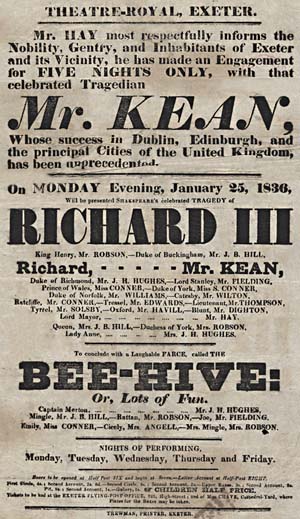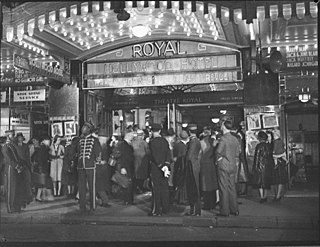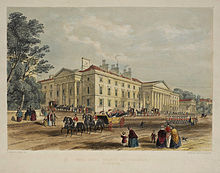
Plymouth is a port city and unitary authority in Devon, South West England. It is located on Devon's south coast between the rivers Plym and Tamar, about 36 miles (58 km) southwest of Exeter and 193 miles (311 km) southwest of London. It is the most populous city in Devon.

The Auditorium Building in Chicago is one of the best-known designs of Louis Sullivan and Dankmar Adler. Completed in 1889, the building is located at the northwest corner of South Michigan Avenue and Ida B. Wells Drive. The building was designed to be a multi-use complex, including offices, a theater, and a hotel. As a young apprentice, Frank Lloyd Wright worked on some of the interior design.

Union Street in Plymouth, Devon, is a long straight street connecting the city centre to Devonport, the site of Plymouth's naval base and docks. Originally the home of wealthy people, it later became an infamous red-light district and the location of most of the city's night-life.

The Auditorium Theatre is a music and performance venue located in the Auditorium Building at 50 E. Ida B. Wells Drive in Chicago, Illinois. Inspired by the Richardsonian Romanesque Style of architect Henry Hobson Richardson, the building was designed by Dankmar Adler and Louis Sullivan and completed in 1889. The Chicago Symphony Orchestra performed in the theatre until 1904 as well as the Chicago Grand Opera Company and its successors the Chicago Opera Association and Chicago Civic Opera until its relocation to the Civic Opera House in 1929. The theater was home to the Joffrey Ballet from 1998 until 2020. It currently hosts a variety of concerts, musicals, performances, and events. Since the 1940s, it has been owned by Roosevelt University and since the 1960s it has been refurbished and managed by an independent non-profit arts organization.

The Grand Theatre, also known as Leeds Grand Theatre and Leeds Grand Theatre and Opera House, is a theatre and opera house in Briggate, Leeds, West Yorkshire, England. It seats approximately 1,500 people.

The Theatre Royal in Bath, England, was built in 1805. A Grade II* listed building, it has been described by the Theatres Trust as "One of the most important surviving examples of Georgian theatre architecture". It has a capacity for an audience of around 900.

The Theatre Royal is a theatre in Brighton, East Sussex, England presenting a range of West End and touring musicals and plays, along with performances of opera and ballet.

The Theatre Royal, Exeter was the name of several theatres situated in the city centre of Exeter, Devon, England in the United Kingdom.

Canberra Theatre Centre (CTC), also known as the Canberra Theatre, is the Australian Capital Territory’s central performing arts venue and Australia's first performing arts centre, the first Australian Government initiated performing arts centre to be completed. It opened on 24 June 1965 with a gala performance by the Australian Ballet.
The culture of Plymouth is a social aspect of the unitary authority and city of Plymouth that is located in the south-west of England. Built in 1815, Union Street was at the heart of Plymouth's historical culture. It became known as the servicemen's playground, as it was where sailors from the Royal Navy would seek entertainment. During the 1930s, there were 30 pubs and it attracted such performers as Charlie Chaplin to the New Palace Theatre. It is now the late-night hub of Plymouth's entertainment strip, but has a reputation for trouble at closing hours.

John Foulston was an English architect who was a pupil of Thomas Hardwick and set up a practice in London in 1796. In 1810 he won a competition to design the Royal Hotel and Theatre group of buildings in Plymouth, Devon, and after relocating he remained Plymouth's leading architect for twenty-five years.

Theatre Royal Sydney (TRS) is a theatre in Sydney, Australia. Earlier theatres also called the Theatre Royal, on the same site, date back to 1833. The current building, designed by modernist architect Harry Seidler, was built in 1976 and has offered a broad range of entertainment since the 1990s. After being closed in 2016, the theatre reopened in December 2021 under parent company Trafalgar Entertainment.

Royal & Derngate is a theatre complex in the Cultural Quarter of Northampton, England, consisting of the Royal Theatre, Derngate Theatre and the Northampton Filmhouse. The Royal was built by theatre architect Charles J. Phipps and opened in 1884. Ninety-nine years later in 1983, Derngate, designed by RHWL, was built to the rear of the Royal. Whilst the two theatres were physically linked, they did not combine organisations until a formal merger in 1999; they are run by the Northampton Theatres Trust. The Royal Theatre, established as a producing house, has a capacity of 450 seats and since 1976 has been designated a Grade II listed building; Derngate Theatre seats a maximum of 1,200 and is a multi-purpose space in which the auditorium can be configured for a variety of events including theatre, opera, live music, dance, fashion and sports. The Northampton Filmhouse, an independent cinema built to the side of the complex, opened in 2013.

John Stanley Coombe Beard FRIBA, known professionally as J. Stanley Beard, was an English architect known for designing many cinemas in and around London.
The Drum Theatre is a theatre in Plymouth, England, part of the Theatre Royal. The Drum Theatre has a capacity of 200 people and specialises in the production of new plays. It won the Peter Brook Empty Space Award in 2007, and often collaborates with other subsidised companies and venues such as the Royal Court, ATC, the Lyric Hammersmith, the Bush Theatre, Frantic Assembly, Hampstead Theatre, Paines Plough, the Traverse Theatre and the Tron Glasgow. In 2007 it put on a production of Flower Girls, a play featuring disabled women.
The following is a timeline of the history of the city of Plymouth, Devon, England.

Plymouth Athenaeum, located in Plymouth, England, is a society dedicated to the promotion of learning in the fields of science, technology, literature and art.

The Minerva Theatre was a theatre located in Orwell Street in Kings Cross, Sydney. Originally a live venue, it was converted to the Metro Cinema in 1950, before returning to live shows in 1969. It ceased operating as a theatre in 1979. From 2019 onwards, there were community efforts to ensure the building would continue operating as a theatre.

The Deco is a restored 1930s cinema and theatre located in the heart of Northampton, England. It is now operated as a venue for corporate, social and theatrical events.

Majestic Picture Theatre is a heritage-listed theatre at 1 Eacham Place, Malanda, Tablelands Region, Queensland, Australia. It was designed by Bob Hassall and built in 1929 by Albie Halfpapp. It is also known as Majestic Theatre. It was added to the Queensland Heritage Register on 5 February 2010.




















